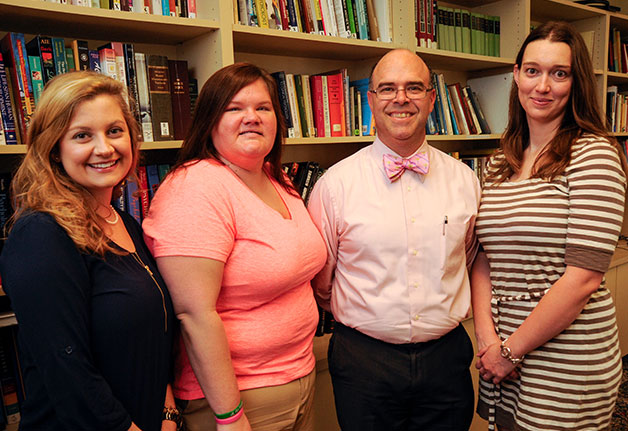Dr. John Lefebvre, chair of the Department of Psychology, expects his Clinical Psychology 420 students to struggle in his class… but he doesn’t expect them to struggle alone.
Three Wofford graduates—Stefanie Carrigan ’05, Erica Cosh ’07 and Paige Forrester Smith ’11, all practicing therapists in the Spartanburg community—took turns returning to campus this spring, presenting real-life scenarios, talking to the class about careers in the field, and serving as sounding boards and advisers for the students, many of whom will become clinicians themselves one day.
“This class helped set me up for success in graduate school. I was constantly referring back to the notes,” says Cosh, who works as the Spartanburg County School District 1 school-based supervisor through Spartanburg Area Mental Health (SAMH). She also does contract therapy at the Children’s Advocacy Center. “I was honored to be asked to return.”
Cosh majored in psychology and sociology at Wofford and earned her master’s degree at the University of South Carolina.
“Even if students in the class are not going to become practicing therapists, everyone in health care is going to deal with people with mental issues,” she says. “This class helps the students realize that their own experiences, biases and issues affect their diagnosis and response to the patient. Being aware helps them remove that variable.”
Smith, who earned a master’s degree in marriage and family therapy from Converse College and went on to earn her state license in the field, also works with SAMH. As the Department of Social Services (DSS) liaison, she assesses clients and does therapy with clients of both organizations.
“This was my favorite class at Wofford,” says Smith, who majored in psychology and minored in religion. “I was prepared for graduate school, but more importantly it has prepared me for the challenges of the workplace.”
Smith says that she takes time out of her day to help with the class because she wants to prepare Wofford students for the different people who will walk through the door.
“Spartanburg Area Mental Health is happy to give us the time to help with Dr. Lefebvre’s class because they want us involved in the community. Also, someone in the class could be the next mental health professional,” she says.
Lefebvre, who designed the class, expects students to finish the course with the ability to think and write like a clinician.
“Other schools often teach this type of class as a how-to, we use a problem-based approach,” he says. “Students study textbook theories then apply them to real-world scenarios. Because they are based on actual situations, the cases are much harder and the lines are fuzzy. The students have to come up with a diagnosis, but they’re not ever sure. They struggle mightily with this, and I want that because that’s what they will experience professionally.”
Carrigan, a psychology major at Wofford who went on to earn a master’s degree in marriage and family therapy at Converse, says the class was beneficial to her for that very reason.
“Cases are not all black and white,” says Carrigan, the Spartanburg County School District 2 school-based therapist with SAMH. “This class helped prepare me for the times I don’t know a definite diagnosis but have to find a way to help anyway.”
Carrigan, Cosh and Smith now feel like they’ve come full circle, and they all believe that helping teach the class is making them better therapists.
“Dr. Lefebvre sends us the students’ papers,” says Carrigan. “These students are smart, and they have fresh eyes and insights. Sometimes they point out something that clicks and that I can use to help a patient.”
According to Lefebvre, Carrigan, Cosh and Smith are in good company. Dr. James E. Seegars, professor emeritus of psychology, was the first professional to present cases to the class. Other local mental health practitioners have followed suit.
“We have a wealth of experience and enthusiasm for sharing that experience right here in Spartanburg,” says Lefebvre. “Our graduates have made good and done well, and we appreciate them returning to share with current students.”
by Jo Ann Mitchell Brasington ’89
